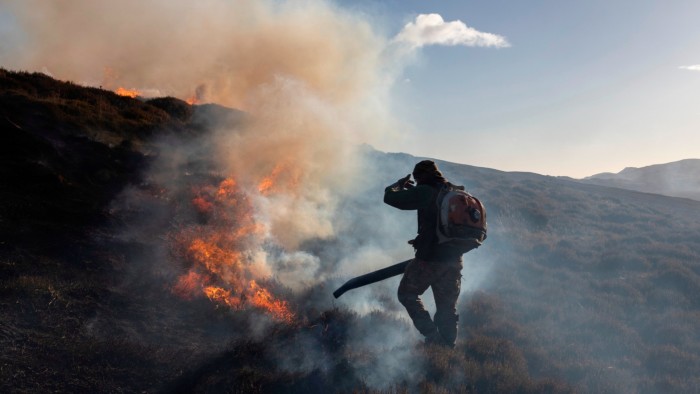Plumes of smoke roll along the brown patchwork of upland moors on Lochan Estate as its gamekeepers burn heather to regenerate leaves for the red grouse. The hut, where guests break from shooting for lunch, stands eerily empty.
Clients, who come from as far as the US and pay £216 per brace, or pair of birds, bagged a record 5,400 grouse over 22 days at the estate in Perthshire, central Scotland in 2017. This year, a late cold snap and fewer insects cut the population, meaning no shooting.
“We could tell in the summer that there weren’t enough brooding pairs; you could see grouse that had lost their young,” said Colin McGregor, who has worked as the estate’s gamekeeper for 37 years. “This business is up and down.”
With just four days left of the season, the same story has echoed around nearby estates and beyond as low stock combines with growing calls for land reform and resistance to shooting to put pressure on the traditional “sport of kings”.
Since the “glorious 12th” that kicked off the season as usual in August, Scottish estates had held about 30 days of driven grouse shooting, said Ross Ewing, moorland director at business group Scottish Land & Estates — a “pitiful” amount compared with the 2,000-3,000 during a good year across the 100-plus estates that host driven shoots.
Extreme, unpredictable weather associated with climate change was creating challenges across the rural landscape, including hitting the breeding success of ground-nesting birds, he said.
Stretching across 10,000 acres of high ground, Lochan’s sporting interests are underpinned by other revenue streams including a wind farm and agriculture.
But McGregor said the lack of business was putting the livelihoods of three families at risk, affecting dozens of casual staff employed as loaders, pickers-up and caterers, and dampening demand for local hotels.
The shooting industry says its activity sustains rural life, but mounting opposition to blood sport and demands to reform national land ownership have left it feeling encircled.
Research published by the British Association of Shooting and Conservation in July showed shooting in Scotland added 14,100 jobs and £760mn to the economy, which is estimated at £218bn including oil and gas.
But Revive, which campaigns for grouse moor reform, cited a Scottish Land & Estates report that found country sports provided little more than 1,000 direct jobs, despite estates taking up 57 per cent of rural Scotland.
“A transition away from grouse shooting is urgently needed — the sooner the better for our people, wildlife and environment, said Max Wiszniewski, Revive campaign director. He called for community-led ownership driven by nature-based industries such as peatland restoration, wildlife tourism and forestry.
The polarised debate around land use in Scotland, where fewer than 500 people own half of private land, is no more vigorous than around the vast tracts of grouse moorland.
Bordering Lochan Estate are large plots owned by Guy Hands, the private equity investor who is developing sustainable forestry, and Oxford university’s endowment fund, where the moorland is left to grow wild.
The arrival of “natural capital” investors pursuing rewilding projects for philanthropy or forestry and peatland restoration to sell carbon credits has lifted land valuations, making grouse shooting increasingly uneconomic.
As McGregor oversaw the burning of heather, known as muirburn, a golden eagle circled high above the ashen moor. The fate of raptors is another subject dividing Scots, with many pushing for tighter regulation to protect birds of prey from illegal killing.
Research by the Scottish government in 2017 found that one-third of satellite-tagged golden eagles had died in suspicious circumstances around grouse moors.
McGregor said the prevalence of birds of prey countered such concerns, blaming wind farms for deaths. Pointing to historically low levels of wildlife crime, Ewing said the recent rise in raptor offences related to illegal laundering of peregrine falcons, rather than moorland management.
Criticism “suits a narrative — many are opposed to hunting and, particularly, driven game bird shooting”, he added.
But Ruth Tingay, a conservation campaigner, said reported crimes were the “tip of the iceberg”, citing continuous reports of shot, trapped and poisoned raptors as well as the rarity of wind turbine strikes.
“Pretending the extent of these crimes is negligible is the mark of an industry desperately trying to ‘greenwash’ its shameful reputation,” she said. “There are huge gaps in the distribution of breeding species like golden eagles and hen harriers in areas intensively managed for driven grouse shooting.”
In early 2022, Lochan was hit by a three-year loss of its general license to control wild birds after allegations of wildlife crime. McGregor, who denies any wrongdoing, called for a neutral ombudsman to hear appeals against sanctions relating to the growing number of regulations.
“There should also be some recognition of the good we do for curlews and lapwings — all critically endangered. Grouse moors are one of the few places they are thriving,” he said.
The Scottish National party government has been legislating for land reform and tighter regulation of estate management as it balances tradition with advocacy for nature and climate policy.
It is implementing muirburn licensing, in recognition of how burning heather cuts wildfire risk by managing the fuel load on moorland while seeking to protect peatlands crucial for carbon storage.
A separate government licensing scheme this year threatened the removal of shooting rights if raptor persecution occurred anywhere on an estate’s boundaries, but was watered down within months.
Tingay said it was a “middle ground step” that, if found not fit for purpose, would fuel demand for an outright ban.
Back on the Lochan estate, in the absence of shooting parties, the team engaged in the daily tasks of maintaining infrastructure and managing the moor.
Richard Stewart, estate manager, was philosophical about the poor season.
“You just have to suck it up and keep going in the hope you can hit a good year to reimburse the investment,” he said.
Read the full article here

